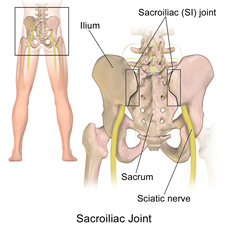Why Is My Sacroiliac Joint Pain Worse at Night?

A: Why is my sacroiliac joint pain worse at night?
The sacroiliac (SI) joint is the joint that connects the hip bone with the sacrum at the base of the spinal column and lies between the large bones of the pelvis. (The pelvis is the group of bones that connects the trunk and the legs.) The SI joint is the largest joint in the body. Strong ligaments around the joint help stabilize it, supporting the weight of the upper body and transferring the load between the spine and the legs. Because its primary function is stability, it’s a very stiff joint and has minimal ability to move. About 15 to 30% of low back pain can be attributed to dysfunction of the SI joint.
Your SI joint can be injured or degenerate as you age and cause low back or spine, pelvic, leg, or buttock pain.
About SI joint pain and sleep, many patients say that it hurts when they move or change positions in bed. Why does that happen, and what are the best sleeping positions to avoid pain?

Motions such as getting up or turning over too quickly may irritate and compress the joint space to cause more pain. To reduce nighttime pain:
- The most important thing you can do is to avoid lying on the side of the affected SI joint. When lying on the painful side, you’re increasing the stress through that joint. Try sleeping with the painful side facing up.
- When sleeping on your side, people often like putting a pillow between their legs to get the body in a more anatomical position (keeping your hips, pelvis, and spine aligned.)
- Lying on your back can be helpful because this reduces the pressure through the SI joint. Placing a pillow underneath your legs can also help relieve some of the pressure on the SI joint.
- Sleep on a supportive mattress that isn’t too soft or too hard. Many patients prefer flexible foam mattresses over coil mattresses and medium-firm or firmer mattresses. Softer mattresses do not provide you with the stability and support your body needs while you’re sleeping.
If you have any concerns about back pain or other spine conditions, contact The Spine Center at Weill Cornell Medicine. We are happy to help you find the best treatment available.
- Jennifer Soo Hoo, physical medicine and rehabilitation specialist
This question was answered during the episode of Spine Time called “Sacroiliac Joint Pain — Getting to the Root of the Problem.” A recording of this webinar, held on December 1, 2021, is available on YouTube. To sign up for future episodes of Spine Time, where you can ask questions of our spine specialists, subscribe here.
More Ask a Spine Doctor
